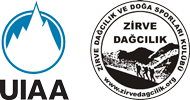| GERİ | Paylaş | 0 |
Bu makaleyi çevirerek ülkemizde ki sınırlı kaynakları geliştirmek adına bize yardımcı olabilirsin. Yapacağınız çeviriler iletişim bilgilerinizle beraber yayınlanacaktır. Bize ulaşın lütfen.

Kanala abone olmak için
Hedef 200 eğitim videosu
Tırmanış konusunda her hafta yeni bir bilgi için abone olun

